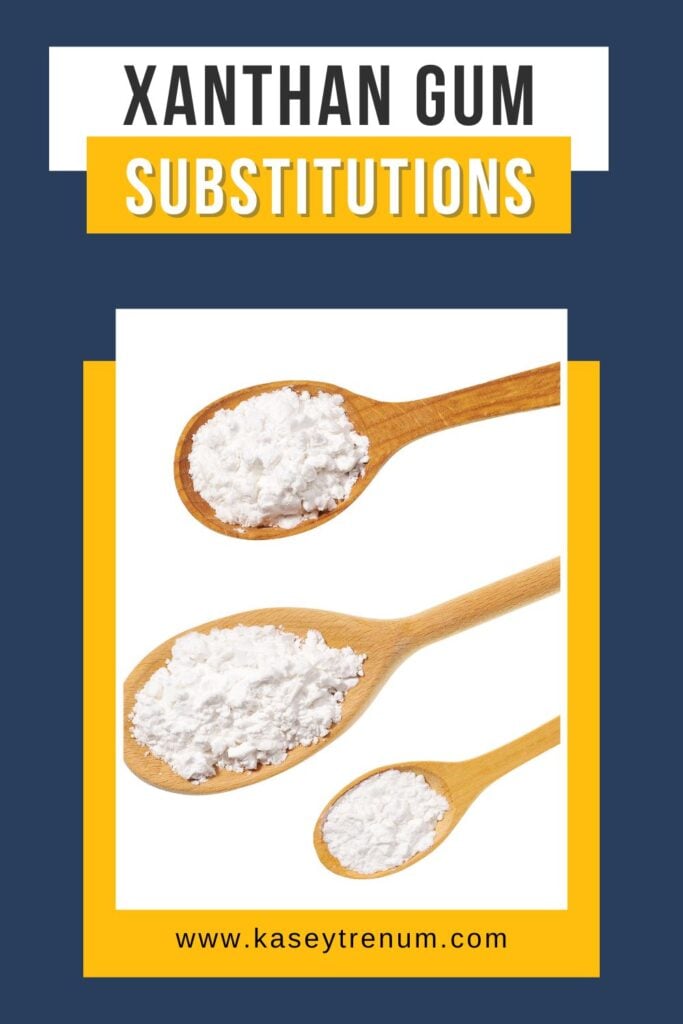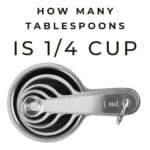Xanthan Gum Substitute: 5 Friendly Alternatives
Are you searching for the perfect xanthan gum substitute for your gluten-free or low-carb baking needs? Look no further as we dive into the best natural alternatives and easy-to-find options that will elevate your recipes to the next level.

Want to save this recipe?
Why You Might Need a Xanthan Gum Substitute
As a passionate baker with years of experience in gluten-free and low-carb cooking, I understand the importance of finding the perfect ingredients to create delicious treats. Xanthan gum is a popular food additive used as a thickener, stabilizer, and emulsifier, especially in gluten-free baking. However, if you don’t have it on hand or prefer natural alternatives, there are several substitutes you can use. This post will explore the best xanthan gum substitutes for gluten-free baking, low-carb cooking, and more.
Understanding Xanthan Gum
Before we discuss the substitutes, let’s examine xanthan gum. This unique food additive is made by fermenting corn sugar with a bacteria called Xanthomonas campestris. The result is a versatile ingredient that’s highly soluble in water and forms a gel-like substance when mixed with liquid (1). It is a popular choice for gluten-free baking because it mimics gluten’s texture and binding properties. It’s also used in low-carb cooking as a sauce, dressing, and thickener.
Properties of Xanthan Gum
Xanthan gum is a unique substance. It is highly soluble in water and forms a gel when mixed with liquid, making it an effective thickener for sauces, dressings, and other liquid-based foods.
It also has a unique ability called shear-thinning, which means mixing or blending it, making it thinner and easier to stir. This unique feature makes xanthan gum an excellent ingredient for many different food recipes because it’s easy to work with and can help improve the texture of your food.
Common Uses
Xanthan gum is used in various food products, including salad dressings, sauces, baked goods, and dairy products. It is often used as a replacement for gluten in gluten-free products since it can provide similar texture and binding properties. It is also used in ice cream to prevent the formation of ice crystals and improve the texture. There are also nonfood uses, such as toothpaste and cosmetic products, as a thickener and stabilizer.
While xanthan gum is a widely used ingredient, some people may have an allergy or intolerance. Several options are available if you are looking for a substitute.
Reasons for Substituting
Here are a few common reasons why you must substitute xanthan gum in your recipes:
Dietary Restrictions
Now that we know what xanthan gum is, you might be wondering why you’d need to substitute it. There are a few common reasons:
Dietary restrictions: If you’re following a low FODMAP diet, you’ll need to avoid xanthan gum due to its high fructan content (2). Similarly, if you have a corn, soy, or dairy allergy, you’ll want to steer clear.
Availability: Xanthan gum can be hard to find in some areas, especially if you don’t live near a well-stocked grocery store.
Personal preference: Some people simply prefer to use natural ingredients whenever possible.
Whatever your reason for seeking a substitute, rest assured that there are plenty of options available!
Remember that different substitutes may work better in various recipes and baked items like cakes, so you may need to experiment to find the best option.
Natural Substitutes
If you prefer to avoid processed ingredients, there are several natural alternatives to use in your recipes.
Guar Gum
Guar gum is a natural thickener that comes from the seeds of the guar plant. It works similarly to xanthan gum, but it is not as strong. You can use it as a 1:1 substitute for xanthan gum in most recipes. Guar Gum is also keto-friendly.
Locust Bean Gum
Locust bean gum is another low-carb natural thickener made from the seeds of the carob tree. It is often used in dairy products and can substitute for xanthan gum in ice cream, yogurt, and other creamy desserts. However, it is less potent, so you may need to use more of it to achieve the same results.
Agar-Agar
Agar-agar is a natural gelling agent made from seaweed. It is often used in Asian cuisine to make desserts, jellies, and other dishes. It can be used as a substitute for xanthan gum in recipes that require a thickening agent. However, it is not as effective as a binder, so it may not work well in all recipes. Agar-agar is also keto-friendly.
When using natural substitutes, keep in mind that they may not work as well in all recipes. You may need to experiment with different amounts and combinations of natural thickeners to achieve the perfect texture and consistency.
Home Pantry Alternatives
If you don’t have xanthan gum in your pantry, don’t worry! You can use several alternatives as substitutes in your recipes. Here are a few home pantry alternatives that you can use instead (3).
Cornstarch
Cornstarch is a common pantry item that can be used as a substitute. It is a fine white powder that is made from corn. Cornstarch is gluten-free and can be used in a variety of recipes. It can be used in the same amount as xanthan gum but is not as effective as a binding agent.
Chia Seeds
Low-carb chia seeds are an excellent substitute. They are rich in fiber and omega-3 fatty acids. When soaked in water, chia seeds form a gel-like substance that can be used as a thickener. To use chia seeds as a substitute, mix one tablespoon of chia seeds with three tablespoons of water and let the mixture sit for a few minutes until it forms a gel-like consistency. Use the same amount of soaked chia seeds as the xanthan gum in your recipe.
Ground Flaxseeds
Ground flaxseeds are low in carbs and another excellent alternative. They are rich in fiber and omega-3 fatty acids, just like chia seeds. Much like chia seeds, ground flaxseeds form a gel-like substance that can be used as a thickener when mixed with water. To use ground flaxseeds as a substitute, mix one tablespoon of ground flaxseeds with three tablespoons of water and let the mixture sit for a few minutes until it forms a gel-like consistency. Use the same amount of soaked flaxseeds as the xanthan gum in your recipe.
Commercial Substitutes
If you don’t have time to make your own substitute, several commercial options are available. Here are some of the most popular:
Pre-Made Baking Mixes
Many baking mixes, such as Betty Crocker and King Arthur Flour, contain xanthan gum. However, if you’re looking for a mix free of xanthan gum, some popular brands include Pamela’s Products and Bob’s Red Mill.
Gluten-Free Flour Blends
Gluten-free flour blends are a great option if you need to avoid gluten, but they often contain xanthan gum. Several gluten-free flour blends are xanthan gum-free. Some popular brands include Cup4Cup and King Arthur Flour Gluten-Free All-Purpose Flour.
When choosing a commercial substitute, read the ingredients list carefully to ensure it doesn’t contain any other ingredients you’re trying to avoid. Also, remember that commercial substitutes may not work as well as homemade substitutes, so you may need to experiment a bit to find the one that works best for your recipe.
How to Choose a Substitute
With so many substitutes available, you might be wondering how to choose the right one for your recipe. Here are a few factors to consider:
Recipe type: Different substitutes work better for different recipes. For example, psyllium husk is a great choice for gluten-free bread and pizza dough, while chia seeds work well in smoothies and puddings.
Texture: Consider the desired texture of your final product. Opt for a fine powder like arrowroot or cornstarch if you want a smooth, creamy texture. If you don’t mind a slightly grainy texture, chia seeds or flaxseeds might be a good choice.
Flavor: Some substitutes, like chia seeds and flaxseeds, have a slightly nutty flavor that can affect the taste of your recipe. If you want a neutral flavor, try a tasteless substitute like psyllium husk or guar gum.
Dietary restrictions: If you’re following a specific diet, like keto or low FODMAP, make sure to choose a substitute that fits your needs.
Remember, finding the perfect substitute for your recipe might take some experimentation. Don’t be afraid to try different options until you find the one that works best for you!
Baking Considerations
You will want to choose a substitute to help your baked goods rise properly and maintain their structure and texture. Some good options include:
- Psyllium husk is a plant fiber that can help hold the ingredients in your baked goods together and make them fluffy. It might also give your treats a slightly nutty flavor.
- Guar gum is a natural ingredient that can thicken baked goods, help them rise, and keep their shape. Some recipes might make the texture a little slimy or gooey.
- Cornstarch is a thickener often used in baking. It can help baked goods hold their shape. But cornstarch isn’t a good choice if you’re baking gluten-free or keto recipes. It can also make your treats feel a bit grainy in your mouth.
Sauces and Dressings
If you’re making sauces and dressings, you will want to choose a substitute that will help thicken without changing the flavor too much. Here are a few options:
- Arrowroot powder is a natural thickener that can smooth your food without changing its taste. But if you cook it for too long, it might break down and not work as well.
- Cornstarch is a common thickener that can make your food feel velvety without changing its flavor too much. However, it might make your food a little grainy, and it’s not a good choice if you’re following a gluten-free or low-carb diet.
- Unflavored Gelatin is a thickener made from protein that can help create a smooth texture without changing the flavor much. Since it comes from animals, it’s not a good option for vegetarians. Gelatin might also add a slight meaty taste to your recipe.
Dairy Products
When making dairy-based recipes, choose a substitute that will help thicken the mixture without changing the flavor too much. A few good options include:
- Agar agar is a thickener made from plants that can help make your food smooth without changing its taste too much. However, it might make your recipe a little bit jelly-like.
- Cornstarch is a thickening ingredient that can make your food smooth and creamy without changing the taste. However, it might make your recipe a tiny bit grainy or sandy. Also, cornstarch isn’t a good choice if you are gluten-free or low-carb.
- Gelatin is a thickener made from protein that can help make your food smooth without changing its taste too much. It’s not a good option if you’re a vegetarian because it comes from animals. Gelatin might also add a slight meaty taste to your recipe.
Many substitutes for xanthan gum can help your recipes achieve the desired texture and consistency. Thinking about the recipe will help you determine which substitute to use.
Substitution Ratios and Tips
Measurement Guidelines
When substituting xanthan gum in your recipe, it is important to understand the ratio of the substitute to the original ingredient. Here are some common ratios for popular substitutes:
- Psyllium husk: Use one teaspoon of psyllium husk for every teaspoon of xanthan gum.
- Chia seeds: For every teaspoon of xanthan gum, use one tablespoon of chia seeds mixed with three tablespoons of water.
- Arrowroot powder: Use one tablespoon for every teaspoon of xanthan gum.
It is super important to note that the amount of substitute needed may vary depending on the recipe. So, it is best to start with a smaller amount and add more as needed.
Mixing Techniques
Mixing ingredients to replace xanthan gum is important to get the desired texture. Here are some tips to help you mix your substitutes properly:
- Psyllium husk: Mix the psyllium husk with the dry ingredients before adding any liquids. Let the mixture thicken for a few minutes, then add the liquids.
- Chia seeds: Combine them with water and let the mixture sit for a few minutes until it becomes thick and gel-like. After that, add it to your recipe.
- Arrowroot powder: Add a small amount of cold water to the powder to make a smooth paste. Then, add this paste to your recipe.
If you follow these tips for measuring and mixing, you can be successful using substitutes in your recipes without problems. Just remember to start with a small amount of the substitute and add more if necessary until you get the texture and consistency you want.
Frequently Asked Questions
What’s a good alternative for xanthan gum in gluten-free baking?
Several options are available to substitute in gluten-free baking. Some good alternatives include guar gum, psyllium husk, chia seeds, flaxseeds, and agar agar. Each of these ingredients can help bind gluten-free flours and improve the texture of your baked goods.
Can I replace xanthan gum with cornstarch in my recipes?
While cornstarch can be used as a thickening agent in some recipes, it’s not a direct substitute. Xanthan gum is a stabilizer and emulsifier, which means it helps to bind ingredients and create a smooth texture. Cornstarch, on the other hand, is primarily used to thicken sauces, gravies, and pie fillings. It doesn’t have the same binding properties as and may result in a slightly grainy texture. If you’re looking for a xanthan gum substitute, it’s best to opt for one of the alternatives mentioned above, like psyllium husk or chia seeds.
Is there a suitable xanthan gum replacement for making ice cream?
If you’re making ice cream at home and need a substitute, you have a few choices. Some good options are guar gum, locust bean gum, and carrageenan. These ingredients can help make your ice cream thicker and creamier and keep it from melting too quickly.
What are the keto-friendly options for substituting xanthan gum?
If you’re on a keto diet and need an alternative in a recipe, you have some excellent options. Psyllium husk, chia seeds, ground flax seeds, and Gelatin can all work well. These ingredients can help hold your recipe together and make it thicker, giving it a better texture.
How can I substitute xanthan gum in sauces, like hot sauce?
If you’re making sauces and need a substitute, there are a few good choices. Arrowroot powder, corn starch, and tapioca starch thicken sauces and improve their texture. These ingredients will also not add strange flavors or smells to your sauce.
Conclusion
Xanthan gum is a versatile ingredient that’s commonly used in gluten-free baking and low-carb cooking. However, if you don’t have it on hand or prefer natural alternatives, there are plenty of substitutes to choose from. From chia seeds and psyllium husk to arrowroot and guar gum, these options can help you create delicious, texture-rich recipes.
When selecting a substitute, consider the type of recipe you’re making, the desired texture and flavor, and any dietary restrictions you may have. Don’t be afraid to experiment with different options until you find the one that works best for you.
I hope this post has been helpful in your search for the perfect substitute. Happy baking!
Sources:
(1) Kubala, J. “What Is Xanthan Gum, and Is It Healthy?” Healthline, 25 Nov. 2019, www.healthline.com/nutrition/xanthan-gum.
(2) Varney, J., et al. “FODMAPs: Food Composition, Defining Cutoff Values and International Application.” Journal of Gastroenterology and Hepatology, vol. 32, no. S1, 2017, pp. 53-61.
(3) Link, Rachael. “9 Healthy Substitutes for Xanthan Gum.” Healthline, 2 June 2022, www.healthline.com/nutrition/xanthan-gum-substitute.




